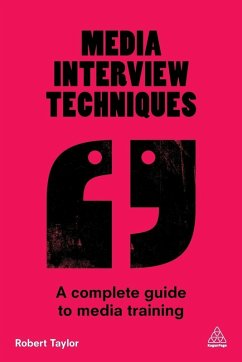- Broschiertes Buch
- Merkliste
- Auf die Merkliste
- Bewerten Bewerten
- Teilen
- Produkt teilen
- Produkterinnerung
- Produkterinnerung
A practical guide to preparing for, conducting, and evaluating the success of media interviews, this book is based on communications expert Robert Taylor's eight-step methodology for polished and confident interview delivery across a range of platforms--TV, radio, internet, and video. Taylor explains how to handle nerves, voice and body language, communicate in a crisis, answer unfair questions, know when to decline interviews, win over skeptical audiences, and create a resonant message.
Andere Kunden interessierten sich auch für
![Medienmanagement und öffentliche Kommunikation Medienmanagement und öffentliche Kommunikation]() Thomas BeckerMedienmanagement und öffentliche Kommunikation34,99 €
Thomas BeckerMedienmanagement und öffentliche Kommunikation34,99 €![CSR und Kommunikation CSR und Kommunikation]() CSR und Kommunikation64,99 €
CSR und Kommunikation64,99 €![Storyverse Playbook Storyverse Playbook]() Bernhard Fischer-AppeltStoryverse Playbook39,00 €
Bernhard Fischer-AppeltStoryverse Playbook39,00 €![Das persönliche Gespräch: Fundraising durch Überzeugung Das persönliche Gespräch: Fundraising durch Überzeugung]() Andreas SchiemenzDas persönliche Gespräch: Fundraising durch Überzeugung49,99 €
Andreas SchiemenzDas persönliche Gespräch: Fundraising durch Überzeugung49,99 €![Vom Exposé zum Bucherfolg Vom Exposé zum Bucherfolg]() Gabriele BorgmannVom Exposé zum Bucherfolg24,99 €
Gabriele BorgmannVom Exposé zum Bucherfolg24,99 €![Finanztango Finanztango]() Klaus Boltres-StreeckFinanztango29,99 €
Klaus Boltres-StreeckFinanztango29,99 €![Schreiben in der Finanzwelt Schreiben in der Finanzwelt]() Marlies WhitehouseSchreiben in der Finanzwelt54,99 €
Marlies WhitehouseSchreiben in der Finanzwelt54,99 €-
-
-
A practical guide to preparing for, conducting, and evaluating the success of media interviews, this book is based on communications expert Robert Taylor's eight-step methodology for polished and confident interview delivery across a range of platforms--TV, radio, internet, and video. Taylor explains how to handle nerves, voice and body language, communicate in a crisis, answer unfair questions, know when to decline interviews, win over skeptical audiences, and create a resonant message.
Hinweis: Dieser Artikel kann nur an eine deutsche Lieferadresse ausgeliefert werden.
Hinweis: Dieser Artikel kann nur an eine deutsche Lieferadresse ausgeliefert werden.
Produktdetails
- Produktdetails
- Verlag: Kogan Page
- Seitenzahl: 226
- Erscheinungstermin: 1. November 2015
- Englisch
- Abmessung: 234mm x 156mm x 13mm
- Gewicht: 351g
- ISBN-13: 9780749474720
- ISBN-10: 0749474726
- Artikelnr.: 42950131
- Herstellerkennzeichnung
- Libri GmbH
- Europaallee 1
- 36244 Bad Hersfeld
- gpsr@libri.de
- Verlag: Kogan Page
- Seitenzahl: 226
- Erscheinungstermin: 1. November 2015
- Englisch
- Abmessung: 234mm x 156mm x 13mm
- Gewicht: 351g
- ISBN-13: 9780749474720
- ISBN-10: 0749474726
- Artikelnr.: 42950131
- Herstellerkennzeichnung
- Libri GmbH
- Europaallee 1
- 36244 Bad Hersfeld
- gpsr@libri.de
Robert Taylor studied at Multnomah School of the Bible from 1971-1974. He received his BA from Lutheran Bible Institute, his MA from Northwest Baptist Seminary, and his DMin from Columbia Evangelical Seminary. Teaching Daniel, Romans, and Revelation for Cascade Bible College, Bellevue, WA, was also invaluable preparation for writing Eternal by Choice.
Foreword
Acknowledgements
01 Why do a media interview?
Have something newsworthy to say!
When to decline a media interview
Summary
Exercises
02 Preparing for your interview
Basic information you need
Anticipate the questions
Know your organization's line on sensitive corporate issues
What's topical in your industry that the journalist might ask you about?
The role of your PR department
Become a great spokesperson
Get media trained
Summary
Exercises
03 How to create a resonant message
Make your business objective action-oriented
No more than three key messages
Constructing a "message sandwich'"
Get to the point ...
Remembering your messages
Summary
Exercises
04 Keeping your cool
Too much adrenaline - nervousness
Too much adrenaline - anger
So should you ever lose your cool?
The exceptions
Not enough adrenaline - over-confidence
What's better: live or recorded?
Summary
Exercises
05 Voice and body language
Eye contact
Posture
Pace of delivery
Other aspects of good voice and body language
Dress sense
Summary
Exercises
06 The perfect tone of voice
A W.I.S.E tone
1 Keeping your delivery as conversational as possible
2 Using mind pictures
All elements of W.I.S.E. working together
Curtailing your curtness
Finding the full stop
Humour
Summary
Exercises
07 Keeping control of the interview
ABC: the bridging technique
The helicopter technique
The caving technique
Avoiding the question - rarely a good idea
Repetition of key messages
How to get off to a good start in a live broadcast interview
Handling unfair questions
The honest truth
Apologizing
Getting your company name into a broadcast interview
Off the record
Summary
Exercises
08 Winning over sceptical and hostile audiences
The spectrum of opinion
Bridges of empathy
Cooling things down
Empathy must be genuine
Attentive listening
Empathy as a message
The 'open sandwich' - starting with your example or evidence then hitting
the key message
Insulting, offending and patronizing people
Empathy in politics
Does empathy work everywhere?
Summary
Exercises
09 Crisis media interviews
How not to handle a crisis media interview
"I'd like my life back"
A formula for handling crisis interviews
Concern/sympathy
Action/explanation
Concern and action working together
Perspective
Being ambushed or "doorstepped"
Summary
Exercises
10 Capitalizing on your interview
Analyse what went well and not so well
Use social media to ensure your interview is seen, heard or read by your
target publics
And if you don't like something the journalist wrote?
Build a strong relationship with the journalist
Summary
Exercises
Bibliography
Index
Acknowledgements
01 Why do a media interview?
Have something newsworthy to say!
When to decline a media interview
Summary
Exercises
02 Preparing for your interview
Basic information you need
Anticipate the questions
Know your organization's line on sensitive corporate issues
What's topical in your industry that the journalist might ask you about?
The role of your PR department
Become a great spokesperson
Get media trained
Summary
Exercises
03 How to create a resonant message
Make your business objective action-oriented
No more than three key messages
Constructing a "message sandwich'"
Get to the point ...
Remembering your messages
Summary
Exercises
04 Keeping your cool
Too much adrenaline - nervousness
Too much adrenaline - anger
So should you ever lose your cool?
The exceptions
Not enough adrenaline - over-confidence
What's better: live or recorded?
Summary
Exercises
05 Voice and body language
Eye contact
Posture
Pace of delivery
Other aspects of good voice and body language
Dress sense
Summary
Exercises
06 The perfect tone of voice
A W.I.S.E tone
1 Keeping your delivery as conversational as possible
2 Using mind pictures
All elements of W.I.S.E. working together
Curtailing your curtness
Finding the full stop
Humour
Summary
Exercises
07 Keeping control of the interview
ABC: the bridging technique
The helicopter technique
The caving technique
Avoiding the question - rarely a good idea
Repetition of key messages
How to get off to a good start in a live broadcast interview
Handling unfair questions
The honest truth
Apologizing
Getting your company name into a broadcast interview
Off the record
Summary
Exercises
08 Winning over sceptical and hostile audiences
The spectrum of opinion
Bridges of empathy
Cooling things down
Empathy must be genuine
Attentive listening
Empathy as a message
The 'open sandwich' - starting with your example or evidence then hitting
the key message
Insulting, offending and patronizing people
Empathy in politics
Does empathy work everywhere?
Summary
Exercises
09 Crisis media interviews
How not to handle a crisis media interview
"I'd like my life back"
A formula for handling crisis interviews
Concern/sympathy
Action/explanation
Concern and action working together
Perspective
Being ambushed or "doorstepped"
Summary
Exercises
10 Capitalizing on your interview
Analyse what went well and not so well
Use social media to ensure your interview is seen, heard or read by your
target publics
And if you don't like something the journalist wrote?
Build a strong relationship with the journalist
Summary
Exercises
Bibliography
Index
Foreword
Acknowledgements
01 Why do a media interview?
Have something newsworthy to say!
When to decline a media interview
Summary
Exercises
02 Preparing for your interview
Basic information you need
Anticipate the questions
Know your organization's line on sensitive corporate issues
What's topical in your industry that the journalist might ask you about?
The role of your PR department
Become a great spokesperson
Get media trained
Summary
Exercises
03 How to create a resonant message
Make your business objective action-oriented
No more than three key messages
Constructing a "message sandwich'"
Get to the point ...
Remembering your messages
Summary
Exercises
04 Keeping your cool
Too much adrenaline - nervousness
Too much adrenaline - anger
So should you ever lose your cool?
The exceptions
Not enough adrenaline - over-confidence
What's better: live or recorded?
Summary
Exercises
05 Voice and body language
Eye contact
Posture
Pace of delivery
Other aspects of good voice and body language
Dress sense
Summary
Exercises
06 The perfect tone of voice
A W.I.S.E tone
1 Keeping your delivery as conversational as possible
2 Using mind pictures
All elements of W.I.S.E. working together
Curtailing your curtness
Finding the full stop
Humour
Summary
Exercises
07 Keeping control of the interview
ABC: the bridging technique
The helicopter technique
The caving technique
Avoiding the question - rarely a good idea
Repetition of key messages
How to get off to a good start in a live broadcast interview
Handling unfair questions
The honest truth
Apologizing
Getting your company name into a broadcast interview
Off the record
Summary
Exercises
08 Winning over sceptical and hostile audiences
The spectrum of opinion
Bridges of empathy
Cooling things down
Empathy must be genuine
Attentive listening
Empathy as a message
The 'open sandwich' - starting with your example or evidence then hitting
the key message
Insulting, offending and patronizing people
Empathy in politics
Does empathy work everywhere?
Summary
Exercises
09 Crisis media interviews
How not to handle a crisis media interview
"I'd like my life back"
A formula for handling crisis interviews
Concern/sympathy
Action/explanation
Concern and action working together
Perspective
Being ambushed or "doorstepped"
Summary
Exercises
10 Capitalizing on your interview
Analyse what went well and not so well
Use social media to ensure your interview is seen, heard or read by your
target publics
And if you don't like something the journalist wrote?
Build a strong relationship with the journalist
Summary
Exercises
Bibliography
Index
Acknowledgements
01 Why do a media interview?
Have something newsworthy to say!
When to decline a media interview
Summary
Exercises
02 Preparing for your interview
Basic information you need
Anticipate the questions
Know your organization's line on sensitive corporate issues
What's topical in your industry that the journalist might ask you about?
The role of your PR department
Become a great spokesperson
Get media trained
Summary
Exercises
03 How to create a resonant message
Make your business objective action-oriented
No more than three key messages
Constructing a "message sandwich'"
Get to the point ...
Remembering your messages
Summary
Exercises
04 Keeping your cool
Too much adrenaline - nervousness
Too much adrenaline - anger
So should you ever lose your cool?
The exceptions
Not enough adrenaline - over-confidence
What's better: live or recorded?
Summary
Exercises
05 Voice and body language
Eye contact
Posture
Pace of delivery
Other aspects of good voice and body language
Dress sense
Summary
Exercises
06 The perfect tone of voice
A W.I.S.E tone
1 Keeping your delivery as conversational as possible
2 Using mind pictures
All elements of W.I.S.E. working together
Curtailing your curtness
Finding the full stop
Humour
Summary
Exercises
07 Keeping control of the interview
ABC: the bridging technique
The helicopter technique
The caving technique
Avoiding the question - rarely a good idea
Repetition of key messages
How to get off to a good start in a live broadcast interview
Handling unfair questions
The honest truth
Apologizing
Getting your company name into a broadcast interview
Off the record
Summary
Exercises
08 Winning over sceptical and hostile audiences
The spectrum of opinion
Bridges of empathy
Cooling things down
Empathy must be genuine
Attentive listening
Empathy as a message
The 'open sandwich' - starting with your example or evidence then hitting
the key message
Insulting, offending and patronizing people
Empathy in politics
Does empathy work everywhere?
Summary
Exercises
09 Crisis media interviews
How not to handle a crisis media interview
"I'd like my life back"
A formula for handling crisis interviews
Concern/sympathy
Action/explanation
Concern and action working together
Perspective
Being ambushed or "doorstepped"
Summary
Exercises
10 Capitalizing on your interview
Analyse what went well and not so well
Use social media to ensure your interview is seen, heard or read by your
target publics
And if you don't like something the journalist wrote?
Build a strong relationship with the journalist
Summary
Exercises
Bibliography
Index








